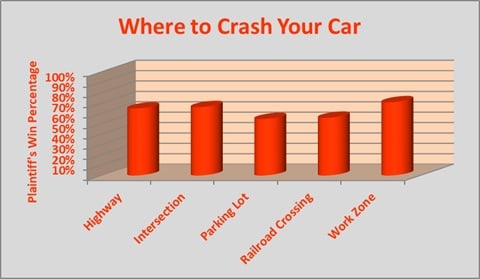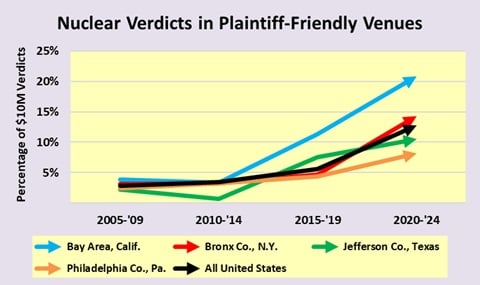VS Insights: Fed or Foe?

Plaintiffs’ attorneys are usually able to choose from among at least two venues when filing a lawsuit, though in the majority of occasions the choices are all state-court venues. Federal court, when an option, can be problematic in that the jury pool is more demographically diverse, and therefore less predictable, than a state-court jury pool. Federal court also tends to be less friendly to plaintiffs, though a good chunk of that is attributable to the differences in subject matter. To help sort it out, we previously surveyed the VerdictSearch database and compared the results in jury trials in federal and state courts. We have done it every two years, each time with similar results. The numbers still show that, while federal courts are more hospitable to defendants overall, there is at least one instance in which a plaintiff may benefit greatly from going the federal route. The accompanying chart comprises four pairs of bars: The red bars reflect plaintiffs’ winning percentage in federal court, and the green bars reflect plaintiffs’ winning percentage in state court. The first two bars represent all cases and depict a slight advantage for state-court plaintiffs. The last three pairs represent three sub-types: government cases, medical-malpractice cases and motor-vehicle cases. The motor-vehicle cases largely run true to form, but government cases are almost a graveyard for federal court plaintiffs. In contrast, medical-malpractice cases, normally a bear in state court, are much more winnable in federal court. The government cases are somewhat explainable by subject-matter differences, but the med-mal anomaly is curious. The takeaway, as usual, is that research can often provide valuable insight when choosing a venue or in any other case-preparation function. Hop onto the VerdictSearch search platform and see what our data shows about your case.
VS Insights: Crash Test

We’ve all heard the saying, “He or she was in the wrong place at the wrong time.” It’s usually used to explain an otherwise inexplicable accident. Is there such a thing as the right place at the wrong time? If you’re driving a car and involved in an accident, the right place is probably a work zone. Stay with us. Using the VerdictSearch database, we sampled motor-vehicle cases to see which places -- for example, work zones, intersections, parking lots -- provide the most favorable outcome for plaintiffs when an accident results in a lawsuit. Work zones are the easy winner, based on a 70.5 percent win rate for plaintiffs in such cases. Intersections and highways are next most favorable to plaintiffs, and railroad crossings and parking lots are least favorable to plaintiffs. The takeaway, as usual, is that research can often provide valuable insight regarding the strength of a case. To check another accident type, use the search platform on Law.com/VerdictSearch.
VS Insights: Nuclear Fallout

This issue’s trend study is a mash-up of two of our favorite topics: plaintiff-friendly venues and nuclear verdicts. Nuclear verdicts, that is, jury verdicts of at least $10 million, have been increasing in frequency steadily in the past 20 years, and sharply in the past 10. It seems reasonable that, if the typical jury has become more inclined to issue a monster verdict, a plaintiff-friendly jury would be even more generous with supersized verdicts. Well … yes and no. The accompanying chart, based on cases reported to VerdictSearch, depicts the frequency of nuclear verdicts since 2005. The black line is the baseline: It shows that nuclear verdicts are a staggering 350 percent more common since 2005! The other lines reflect results in four of the country’s most plaintiff-friendly venues: California’s Bay Area counties, Alameda and San Francisco, which are represented by the blue line; New York’s Bronx County, represented by the red line; Jefferson County, Texas, represented by the green line; and Philadelphia County, Pennsylvania, represented by the orange line. Somewhat surprisingly, the frequency of nuclear verdicts is below the nationwide rate in two of the plaintiff-friendly venues, Philadelphia and Jefferson Counties, though it is above the nationwide rate in the other two venues … with California's Bay Area counties being far above the nationwide rate. Just another reminder that venue bias is not always consistent. The takeaway: Research trends and see for yourself before making a decision about the value of your case.
VS Insights: Governmental Blues

The ongoing call for police reform will undoubtedly reverberate in the realm of civil litigation. Governmental entities will likely face taller hurdles when defending these cases, and it’s a good bet that settlements will become more common and more costly. But the reality is that police cases have been increasingly more troublesome for governmental entities for quite some time, as demonstrated by the accompanying chart, based on cases reported to VerdictSearch. The chart tracks almost 20 years of recoveries in cases involving governmental defendants. The blue bars represent median recoveries in police cases. The darker blue bar reflects jury verdicts, and the lighter blue bar reflects settlements. Note the sharp increase in recoveries in the past 10 years, particularly for jury verdicts. For perspective, the chart also depicts the recovery trend for governmental cases involving falls. The red bar reflects jury verdicts, and the pink bar reflects settlements. Recoveries have increased here too -- as they have in most areas of civil litigation -- but not nearly as dramatically as the police cases have. So while governmental defendants are indeed feeling the effects of social inflation, the impact is greatest when the governmental defendant is a law-enforcement officer. To check the trend in your area, use the research platform on Law.com/VerdictSearch.

